Picking up fish food at the pet store doesn’t require much effort. You can grab a container of flakes or pellets without any trouble.
Even live or frozen foods don’t present obstacles. But expenses start to add up, especially as tank size increases.
If you have a mammoth community aquarium, you may find yourself carting around a massive basket of fish food every month.
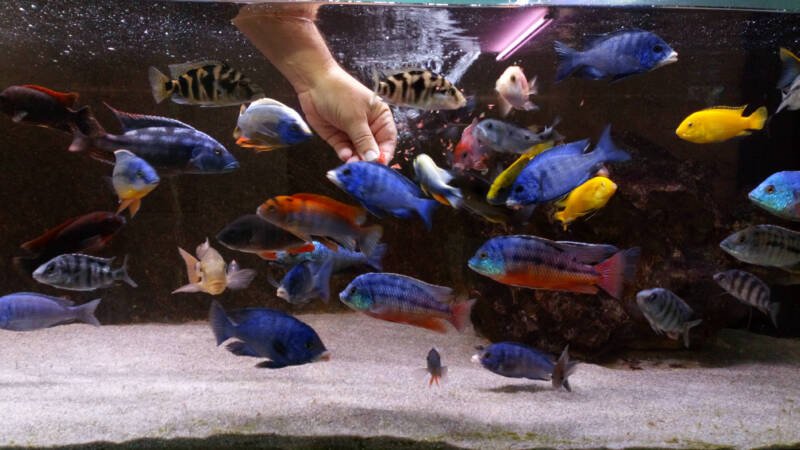
How to satisfy the appetites of EVERY fish in the tank? After all, odds are your different fish species prefer something different.
Switching over or even supplementing that haul with homemade fish foods can ease the financial burden.
Your fish still get balanced diets, but you don’t have to break the bank. Even better, you eliminate some of those pesky processing chemicals and additives.
In this article
Commercial Fish Foods
Have you ever looked at the ingredient label for your fish food?
Most flake and pellet foods feature two primary ingredients: wheat flour and potato starch.
These carbohydrate fillers don’t contribute to nutrition – they simply stabilize the food.
A long shelf life might be necessary. After all, paying for fresh food all the time WILL bankrupt most aquarists. (And spoil your fish)
But fish don’t need that level of carbohydrates. Flour and starch are just the cheapest options to prolong the food’s lifespan.
You’ll also see long strings of chemical preservatives (most of which the average person can’t pronounce or recognize).
Again, these compounds keep the flakes and pellets fresh on the shelf for long periods. They’re not so great for your fish, though.
Homemade fish foods give you better control over what goes into your fishes’ stomachs.
You can eliminate the higher levels of those carbohydrates and get rid of the chemicals entirely. Then you can feel safer, come feeding time.
Diet: What’s on the Menu?
Embarking on homemade fish foods sounds simple – and it is. However, you need to keep a few things in mind.
First and foremost: what kind of diets do your fish need?
Catering to the biological needs of your fish determines the ingredients you’ll want to keep on hand.
Carnivores
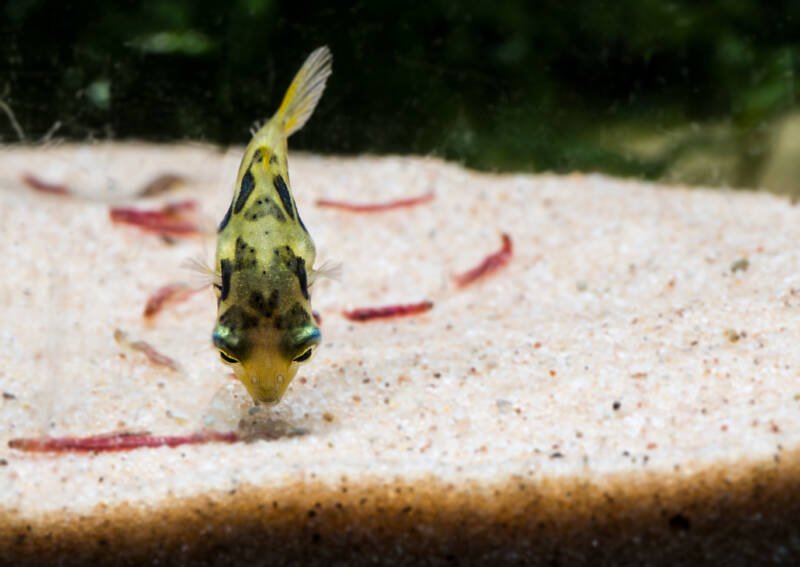
Not many freshwater fish fall into the “true carnivore” category.
Many cichlids lean towards the meatier side of the menu, but they still prefer a helping of greens on the side.
EVERY carnivorous fish needs a balance of 75% meat and 25% vegetables.
Herbivores
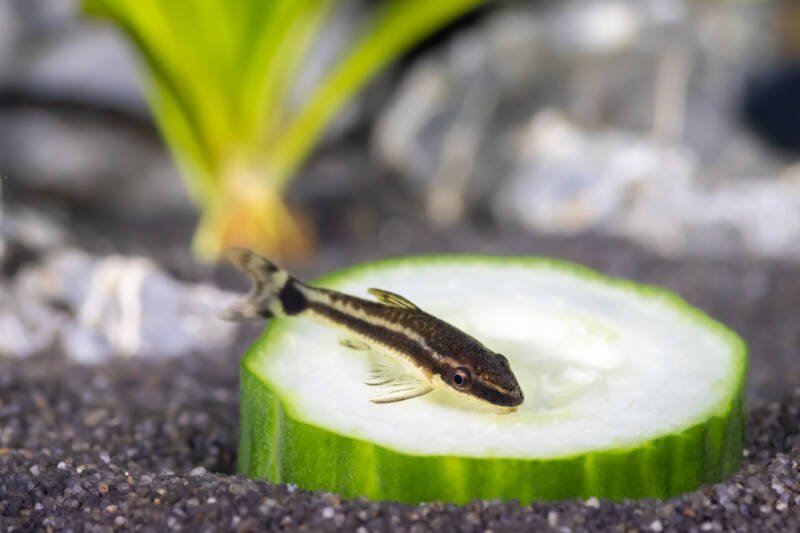
As surprising as it sounds, there are as few “true herbivores” as there are carnivores.
Most of the algae-eaters reach the distant end of the spectrum. However, many herbivorous fish still need a healthy dose of meaty protein in their diet – at least 40%.
Omnivores

Most freshwater fish rank as solid omnivores. They enjoy a little mixture of everything.
This makes formulating homemade fish food fun and easy, as you can combine a lot of different recipes.
You want to strike a proper mixture of 65% meat and 35% vegetables.
Selecting Your Ingredients
You already know what you DON’T want to include in your homemade fish food. But what ingredients do you want to keep around the house?
You can’t dump whatever you pull out of the garden into the blender and call it a day.
And while it’s tempting to scrape the remains of your dinner plate into the fish tank, that won’t work, either.
Some proteins contain too much fat for your fish species to handle. (Not to mention the leftover sauces and spices aren’t healthy)
Fruits and Veggies
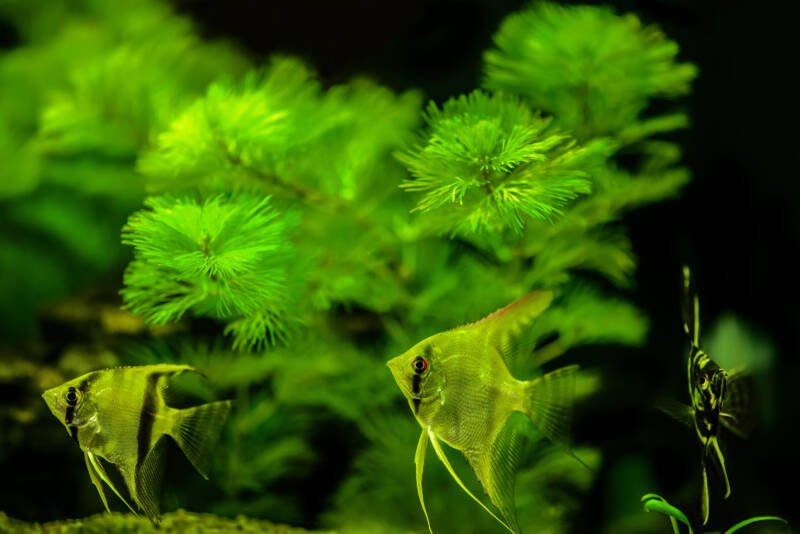
Terrestrial plants have THICK cell walls. They’re difficult for your fish’s GI system to break down.
Aquatic plants don’t have the same cell walls, which is why adding live plants to your aquarium always balances the leafy side of your fishes’ diet.
Popular fish plant choices (which are also easy to care for) include:
- Cabomba
- Egeria
- Limnophila
If you opt for garden fruits and vegetables, you need to peel and blanch them first.
This involves dropping them into boiling water for a few minutes. You then immediately remove them and set them on ice to stop the cooking process.
Blanching doesn’t destroy the nutrients; it just starts breaking down the cell walls. This makes the plant easier for your fish to consume.
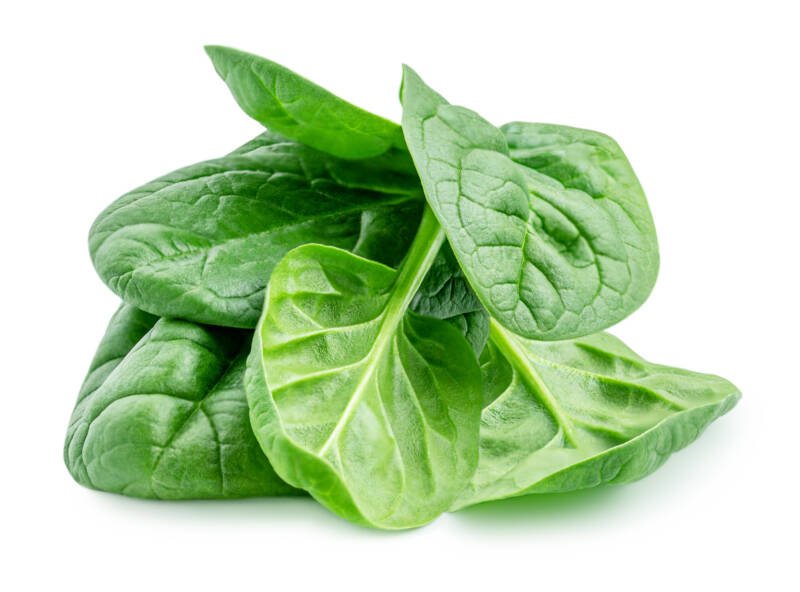
Popular fruits and vegetables to use in homemade fish foods include:
- Apple
- Broccoli
- Carrot
- Cauliflower
- Cucumber
- Kale
- Lettuce
- Pear
- Peas
- Spinach
Try to avoid bananas, corn, parsnips, and sweet potatoes. Their cell walls are TOUGH, and they’re high in carbohydrates.
Your fish don’t need to contend with either one. If you use them, use small amounts.
Protein
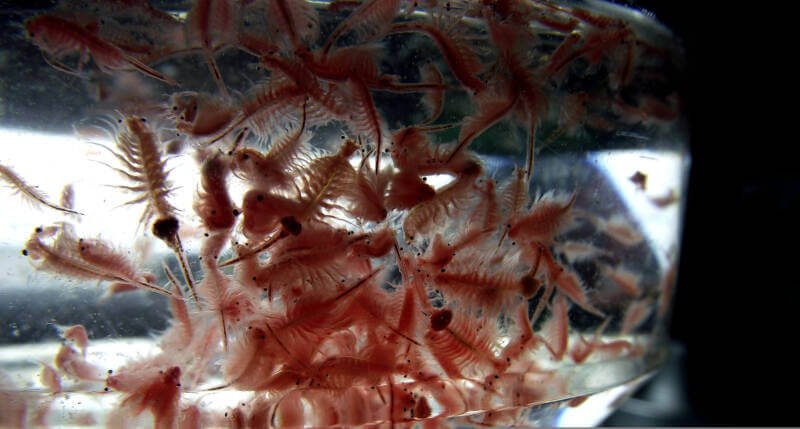
Finding protein sources for fish may sound daunting at first, but it’s relatively simple.
Think about it: most fish eat other fish. Cod, salmon, tilapia, trout, and tuna make excellent protein sources for your homemade fish food.
Shellfish often appear on the standard fish menu. Whether you choose to go for fresh or freeze-dried versions (fresh is always better), you have plenty of options to choose from.
Just consider what you currently feed your fish:
- Brine shrimp
- Krill
- Mussels
- Shrimp
When you eat your shellfish, odds are you remove the shells. When preparing your homemade fish food with krill or shrimp (thin-shelled options), though, leave some of the shells in place.
The “roughage” aids your fish in digestion – something that replicates natural feeding.
And, of course, how can you overlook worms?
Bloodworms, Earthworms, and Tubifex worms make the perfect blend of protein and healthy fat for carnivorous and omnivorous fish species. They’re easy to find at bait shops or pet stores, too.
Supplements
Do you take a daily vitamin? Or add boosts or supplements into your smoothie?
You need to do the same with your homemade fish food. Fruits and protein don’t cover all the bases.
You need to formulate a balanced diet to keep your fish happy, healthy, and colorful.
Garlic
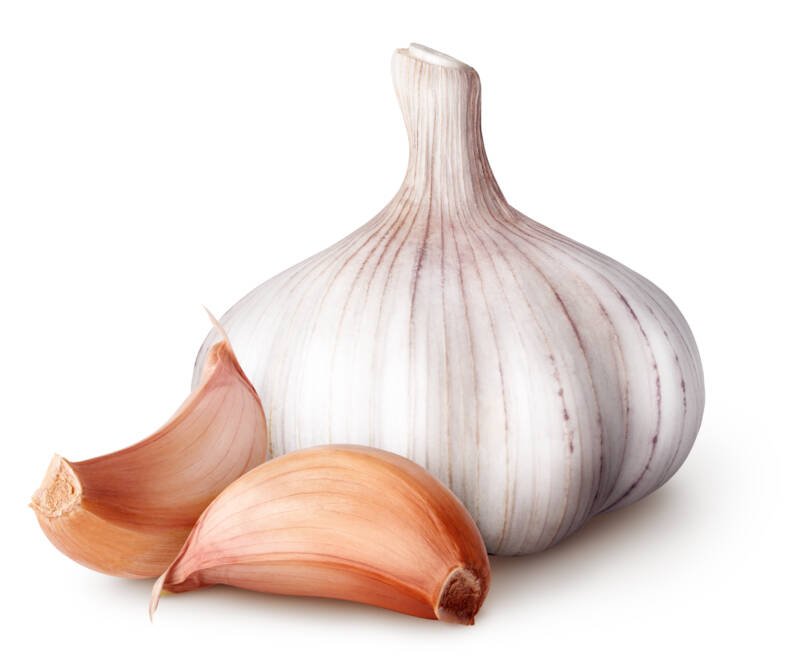
Garlic provides several beneficial properties to your fish. A natural antibiotic, it also aids in digestion and boosts immunity.
A little chopped garlic enhances the flavor of your homemade fish food, stimulating the appetites in your tank.
You can chop whole garlic cloves into your homemade preparations, puree the cloves, or even purchase liquid extracts.
This natural herb is THAT potent. If you want, SeaChem makes their own extract just for aquarists.
Carotenoids & Flavonoids
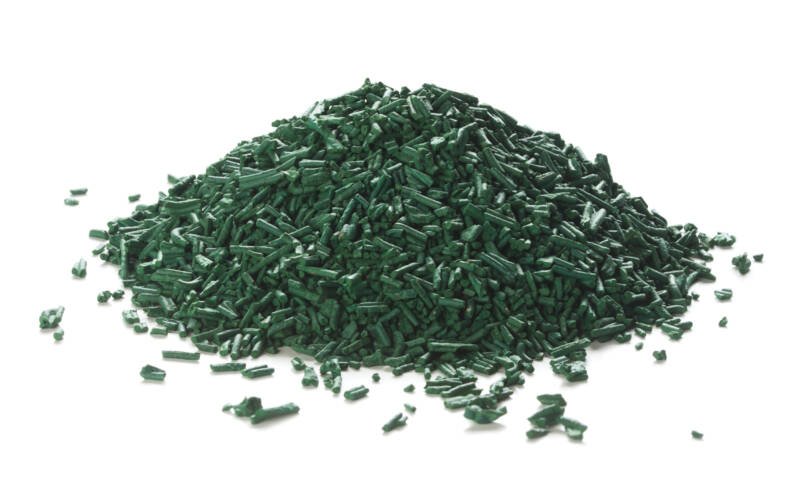
Your tank is a burst of color. Your fish gain those vibrant shades from the foods they eat.
Choosing various colorful fruits and vegetables aids in keeping your fish looking their best, such as beets, bell peppers, and carrots.
However, you can also add beta-carotene powder or spirulina powder into the homemade fish food to give an added punch.
Beta-carotene adds to red and orange hues. Spirulina (made from cyanobacteria) adds yellow pigments.
Gelatin vs. Agar
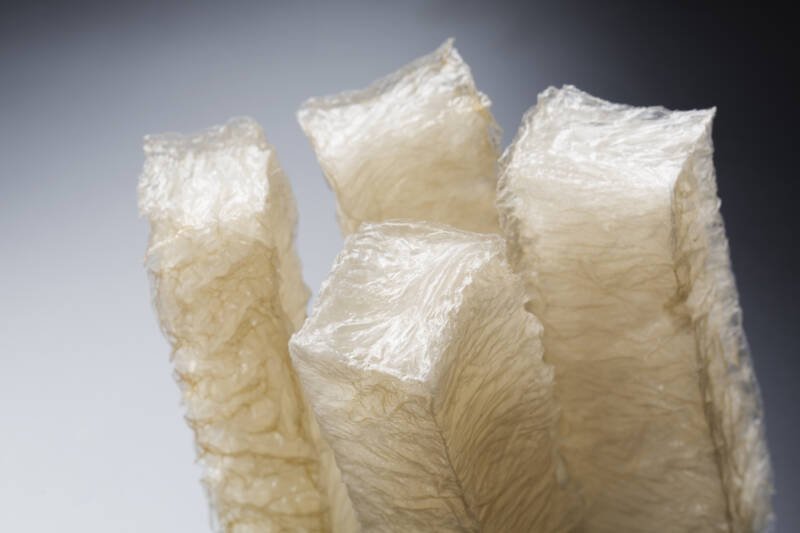
Homemade fish foods often use gelatin to hold the resulting mixture together. Gelatin replaces the wheat flour and potato starch as a filler.
Unhappily, there’s no nutritional value to gelatin, either. It can stuff your fish without providing nutrients.
If you can find it, consider using agar instead, it is a seaweed extract packed with calcium.
It works as a binder without stuffing your fishes’ stomachs.
Other alternatives that work include vegetable flours and infant oatmeal.
Necessary Equipment
Making your homemade fish foods requires some equipment you need to dedicate specifically to the task.
Remember, even if you have a tank of herbivores, they need meat in their diet.
Do you want to share your smoothie blender with your fish? (Probably not)
Preparing homemade fish food requires the following:
- A Blender: This needs to be a high-quality blender. Think of the ingredients you’re working with. A smoothie blender may not have enough power to slurry fish and shellfish. Another option is to use a food processor, though this may cost more.
- A Sharp Knife: Take as much burden off the blender as you can. Cut your ingredients into smaller pieces before you mix them.
- A Saucepan: ALL vegetables require blanching before they’re incorporated.
- Gram Scale: Whether you use a digital or analog scale, you need precise measurements. You’ll replicate the recipes better and keep your homemade fish food on track.
- Ice Cube Trays: The trays work as molds for your completed foods. If you save the trays from frozen foods you’ve purchased in the past, they work better. Plus, they’re the perfect size for feeding.
- Plastic Wrap: You don’t want your fish food to get freezer burn. The plastic wrap creates a safe barrier (unless your ice cube tray has a cover).
Homemade Fish Food Recipes
Once your blocks of homemade fish food freeze solid, you can take them out of the trays and collect them in a Ziploc bag.
All of these recipes store well for up to twelve months. Each block feeds a standard 50-gallon or 200 l aquarium.
It’s essential to strike a balance between your fishes’ old food and the new homemade food, so you don’t shock their systems.
Gradually make the change – feed a commercial diet in the morning and your new homemade diet in the evening.
And be prepared for your fish to hate the new diet. Fish get picky. They may not like your chosen recipe.
You can always change ingredients around to find one they prefer.
That’s the beauty of homemade – you control what goes into the mix!
Homemade Carnivore Fish Food
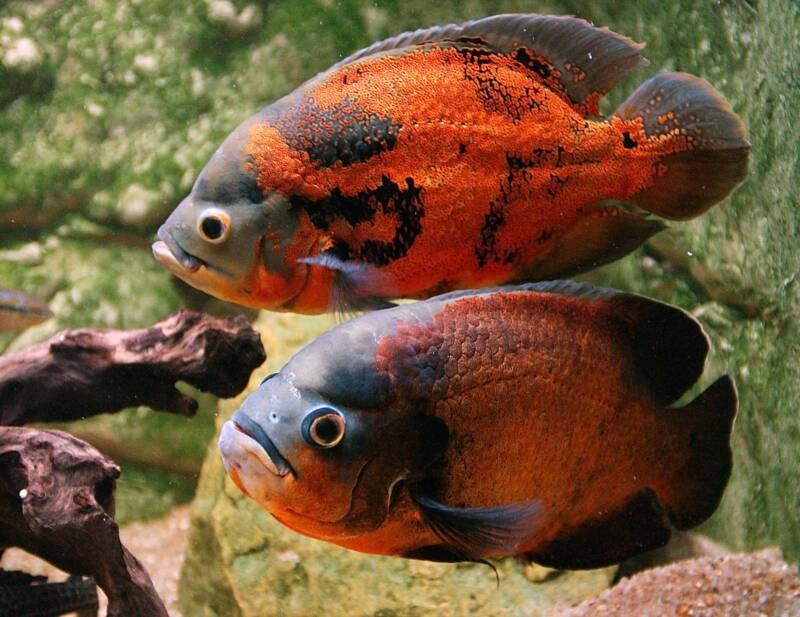
If you have carnivores swimming around your tank, you need to satisfy their protein needs.
A happy, healthy predator won’t be as likely to snack on their tank mates. Make sure you source quality protein sources when you prepare these diets.
Standard Carnivore Diet
Ingredients:
- 136g (4.8oz.) White Fish of Choice
- 136g (4.8oz.) Shrimp
- 136g (4.8oz.) Vegetables
- 268g (9.5oz.) Gelatin or Agar
Instructions:
- Prepare the gelatin/agar according to package instructions.
- Cut and peel the vegetables and blanch them.
- Blend the vegetables into a puree.
- Blend the fish and shrimp.
- Mix everything together.
- Pour into ice cube trays and freeze.
High-Protein Carnivore Diet
Ingredients:
- 100g (3.5oz.) Fresh Fish of Choice
- 100g (3.5oz.) Fresh or Frozen Shrimp
- 100g (3.5oz.) Mussels
- 100g (3.5oz.) Squid
- 100g (3.5oz.) Octopus
- 2.5g (1/2 tsp) Garlic Cloves (Peeled)
- 200g (7.0oz.) Mixed Vegetables
- 2 General Multivitamins
Instructions:
- Thaw any frozen ingredients and cut them into small pieces.
- Combine all ingredients into the blender.
- If too thick, add freshwater.
- Pour into ice cube trays and freeze.
Homemade Herbivore Fish Food

Even if you keep edible plants in your aquarium, changing the variety of fruits and vegetables you offer makes a difference in your fishes’ health.
You’ll need to do a little extra prep work to make the veggies fish-accessible, but your fish will appreciate your effort.
Standard Herbivore Diet
Ingredients:
- 136g (4.8oz.) Spinach
- 136g (4.8oz.) Cucumber
- 136g (4.8oz.) Frozen Peas
- 136g (4.8oz.) Oats
- 268g (9.5oz.) Gelatin or Agar
Instructions:
- Prepare the gelatin or agar according to package instructions.
- Cut and peel the cucumber and blanch the spinach and peas.
- Blend the vegetables into a puree.
- Add the oats and blend again.
- Add the gelatin or agar.
- Pour into ice cube trays and freeze.
Veggie Delight Herbivore Diet
Ingredients:
- 907g (2lb.) Shrimp
- 227g (8oz.) Salmon
- 454g (1lb.) Frozen Chickpeas
- 454g (1lb.) Frozen Spinach
- 454g (1lb.) Baby Carrots
- 1 Zucchini
- 53g (1/4 cup) Spirulina Powder
- 6 General Multivitamins
- 120g (4.2oz.) Gelatin or Agar
Instructions:
- Prepare the gelatin or agar according to package instructions.
- Peel and blanch the baby carrots and zucchini.
- Dissolve the multivitamins in water.
- Cut the salmon into small pieces.
- Combine all the ingredients into the blender.
- Pour into ice cube trays and freeze.
Homemade Omnivore Fish Food

Realistically, every one of these diets can work for omnivores.
The balance between the protein and vegetable matter may not keep your fish as healthy, though.
If you want to cycle between different recipes, you’ll keep a nice variety, offering a change of pace for your fish.
Standard Omnivore Diet
Ingredients:
- 454g (1lb.) Spinach
- 227g (8oz.) Broccoli Stems
- 2 Garlic Cloves (Peeled)
- 1 Zucchini
- 1 Winter Squash
- 227g (8oz.) Sunfish (Skin On)
- 4 Earthworms
- 30g (1 tbsp) Cornstarch
Instructions:
- Remove the stringy interior of the winter squash and peel the zucchini.
- Blanch the remainder of the vegetables.
- Blend all of the ingredients together.
- Pour into the ice cube trays and freeze.
High Protein Omnivore Diet
Ingredients:
- 200g (7oz.) Fresh Salmon
- 70g (2.50z.) Gelatin or Agar
- 500g (17.6oz.) Frozen Peas
- 300g (10.6oz.) Carrots
- 500g (17.6oz.) Spinach (Fresh or Frozen)
- 53g (1/4 cup) Spirulina Powder
- 1kg (35oz.) Shrimp
- 6 General Multivitamins
- 5g (1 tsp) Garlic Cloves (Peeled)
Instructions:
- Place the saucepan on low heat, half-full of water. Add half of the gelatin or agar.
- Cut the shrimp, salmon, and spinach into small pieces.
- Blend all the ingredients (except the gelatin or agar).
- Add the slurry and the remainder of the gelatin or agar to the saucepan.
- Keep on low heat for 30 minutes.
- Pour into the ice cube trays and freeze.
Straight from the Heart
Homemade fish food opens up a lot of possibilities.
You can experiment with different fruits, vegetables, and even proteins in your recipes.
You’ll move away from unnecessary preservatives and starches your fish DON’T need. You might even connect with other DIY dieters!
Have you formulated homemade fish foods? What are some of your favorite recipes?
Share them with us here!